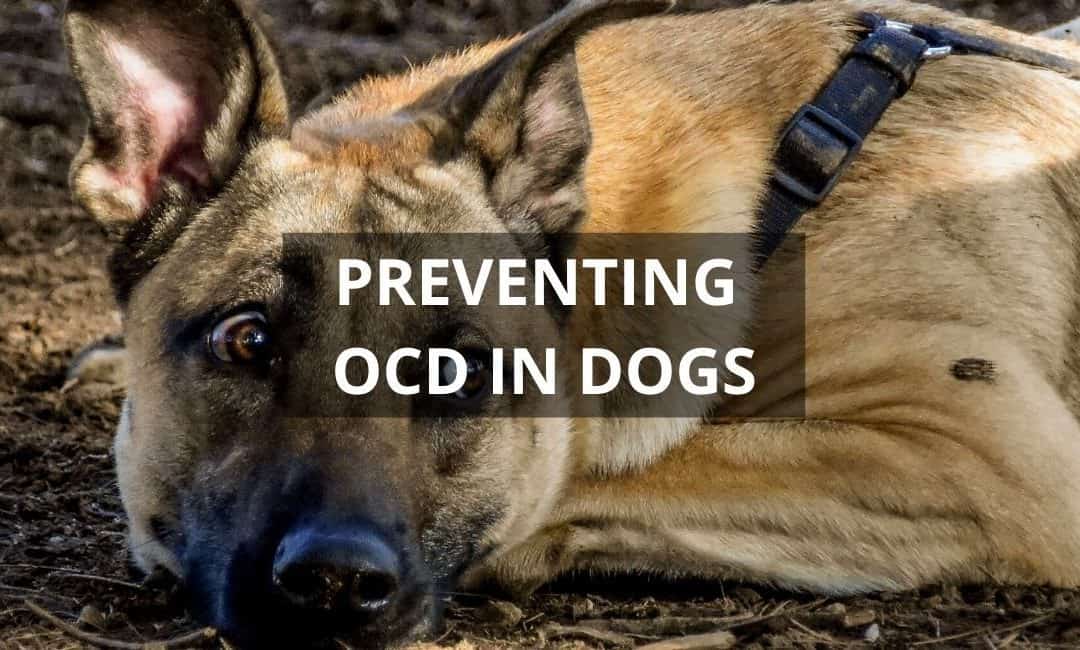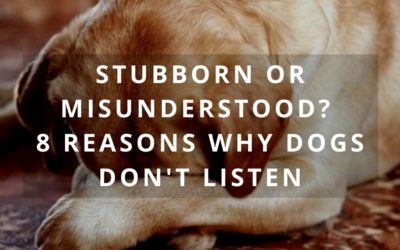Think your high-strung, high-energy, or anxious, insecure dog may be prone to compulsive behavior? All the evidence shows that OCD behavior in dogs can be very challenging to cure once established. So, you may be wondering if there are any steps you can take to prevent it.
Are there strategies to help prevent OCD behaviors in dogs? Well, let’s look at what we know.
We know that most dogs require a combination of environmental, lifestyle, and/or relationship factors to develop OCD. These influences in a dog’s life tend to push them toward neurotic, compulsive behaviors. That’s on top of any genetic predisposition to the disorder an individual dog may have.
If those influences work together to push a dog toward OCD, it makes sense to conclude that if we avoid exposing the dog to these types of influences, we have a good chance of preventing OCD from starting in the first place.
And in dogs with a strong genetic predisposition to compulsive disorders? Again, it makes sense that if we follow some basic OCD prevention guidelines, we should be able to at least reduce the severity of any compulsive behaviors that develop.
Some of the suggested prevention measures below are universal, in that they apply to any type of canine OCD. Others are more specific for certain types of dog temperaments and OCD behaviors. Some are taken from OCD treatment protocols, and others are based on my own observations as a dog trainer and behavior specialist.
All are common-sense suggestions from a behavioral point of view. There’s nothing extreme, and nothing suggested that would harm any dog, OCD-prone or not.
Common-sense caveat: The information here is in no way intended to replace proper veterinary diagnosis or treatment.
If your dog is showing early signs of compulsive and/or repetitive behaviors, first contact your veterinarian. You may get referred to a specialist or veterinary behaviorist for tests and behavioral help.
Compulsive-repetitive disorder in dogs can be very serious and is not something to deal with on your own.
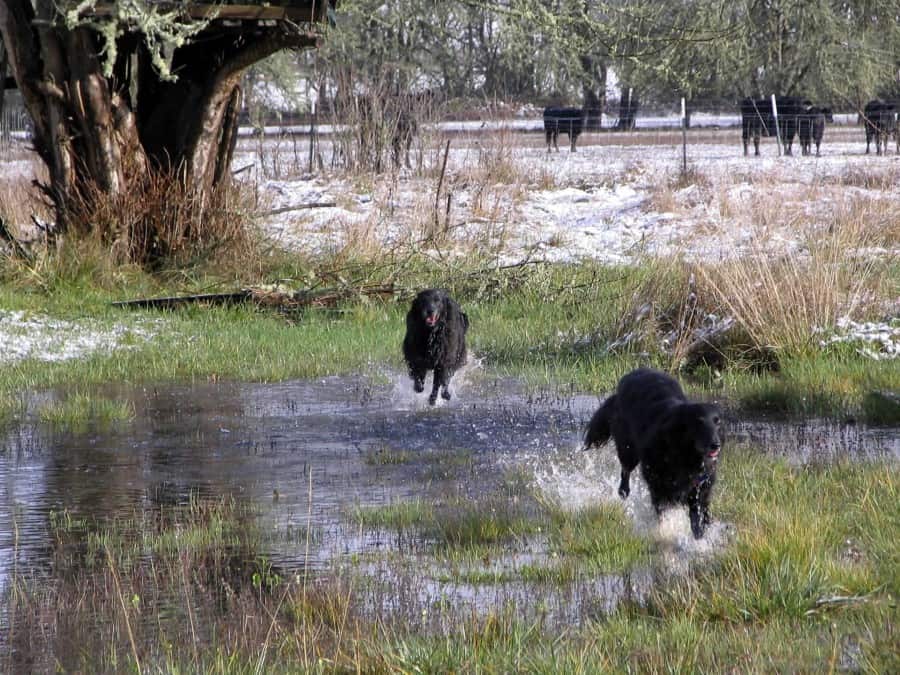
OCD Prevention Tips for Dogs
Provide Plenty of Physical Exercise
Lack of adequate exercise in high-energy, high-strung dogs is a commonly cited factor in the development of compulsive behavior.
Exercise doesn’t need to be excessive; you don’t need to run your dog till he drops! But you do need to make sure your dog gets sufficient physical exercise to keep him satisfied and even-keeled.
How much exercise do dogs need? It’s very individual, but generally, hunting, herding, and working breeds typically need more exercise than more docile, easy-going dog breeds.
Keep in mind that, regardless of breed, a daily on-leash walk around the neighborhood is unlikely to be adequate exercise for any but small, low-energy, and limited mobility dogs.
Tips on how, and how much, to exercise your dog:
How to Choose the Best Exercise for Your Dog
How Much Exercise Does My Dog Need?
How Much Exercise Does A Dog Need Every Day? | 26 Ideas That Work
Confine Wisely
Cramped, sterile confinement environments that provide no relief from boredom are a widely recognized contributing factor in compulsive behavior in animals.
Of course, depending on your circumstances, your dog may well require some confinement for part, most, or all of its life.
Puppies need to be confined when not supervised, to prevent housetraining accidents and puppy chewing. Teenage dogs may need confinement to prevent turning the house or yard into a big, messy playroom. Even adult dogs might need to be confined for similar reasons.
That said, once past the housetraining stage, your dog’s confinement area should be as large a space as is practical. It should have a variety of things in it for the dog to entertain itself with.
The amount of time spent confined alone should be kept to an absolute minimum. If your dog will need to spend an entire workday home alone crated, have a friend or dogwalker come in to give your dog a midday break.
However you set it up, provide a roomy, interesting environment for your dog to stay in when you’re away. Avoid cramped, sterile environments at all costs, and keep time spent in enclosures to a minimum.
Tips and inspiration for better dog confinement:
Puppy Confinement | Keep Your Puppy and Belongings Safe
Confinement Strategies: Options for Peace of Mind and Safety
Why I Don’t Use a Crate When Training Dogs
Canine Enrichment: Create a Backyard Paradise for your Dog
20 Creative DIY Dog Playground Ideas for the Backyard
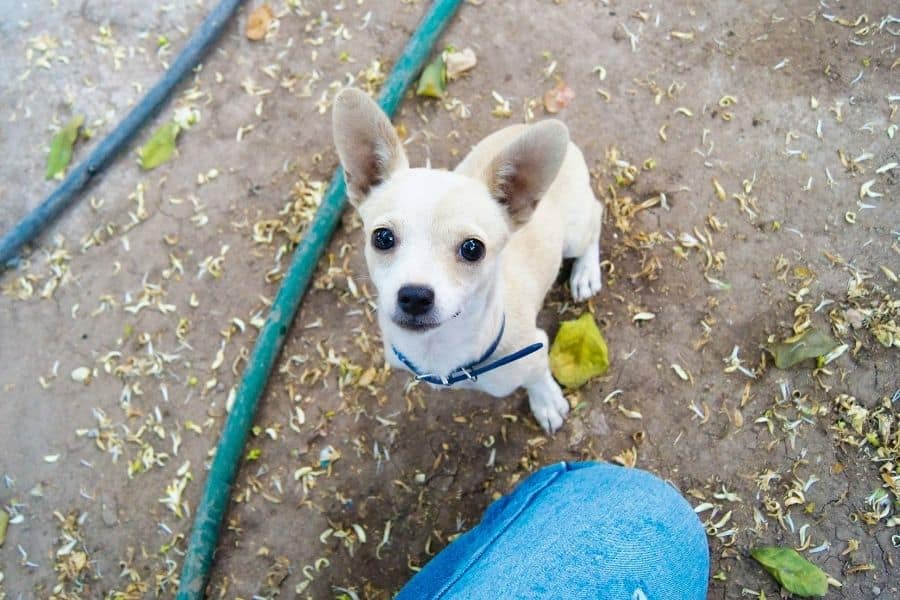
Create a Framework of Life Rules
Structure provides predictability. Predictability provides reassurance. Sure, we all like some excitement and spontaneity in our lives, but basic life rules should not be something we have to guess at.
Without a framework of rules in everyday life, we get anxious. We lose our peace because we sense there is no sure way to get through our day safely. Our dogs are the same way, if not more so.
A clear, predictable, fair set of life rules allows your dog to relax and be sure that his actions have predictable consequences.
What that means is, he knows “how to win”. Everyone deserves that, and an OCD-prone dog has absolute need of it.
Why and how to create structure for your dog:
Structure and Rules: Why They Make Your Dog a Better Companion
Be A Good Leader
Impulsive dogs, anxious dogs, high strung dogs, territorial dogs – all these types are at higher risk of compulsive behaviors. Another commonality is that leadership is not just important, it’s a must.
Being a kind, reliable, benevolent leader lifts a huge weight of responsibility from your dog’s shoulders. This is something every dog needs, not just dogs prone to OCD.
Be a great dog owner by learning how to be a great leader to your dog.
Learn more about leading your dog:
The Role of Leadership in Dog Training
Learn Fair and Balanced Communication
Training is communication, and vice versa. While true with every dog, owners of OCD-prone dogs should avoid training and correction methods that use threats, harsh physical force or highly charged emotional outbursts from the owner.
Learning is hard enough without fear and conflict being part of the mix. Regardless of what training method you choose, it should be done with patience, kindness, and consistency, if you want to avoid the stress, anxiety, and conflict that can trigger OCD.
Great tips on better communication with dogs:
How to Communicate Effectively with your Dog
Get Life Skills in Place – Now
Important life skills for potential OCD dogs include self-control, a reasonable repertoire of reliable obedience behaviors, and an ability to redirect attention in the face of distraction and excitement.
Note that these are skills, not something dogs are born knowing how to do. Skills are first taught, then strengthened through practice.
Work on these important life skills regularly. Start small and easy, and increase difficulty gradually as your dog gains maturity and experience.
Self-control is the ability for a dog to control its emotions and impulses, particularly in difficult situations.
Some dogs are gifted with wonderful natural ability for self-control, while others have to learn it from scratch. All can improve with practice and reinforcement!
Self-control tips and exercises:
The Importance of Teaching Your Pup Self-Control
Help Your Dog Learn Self Control
Impulse Control Games for Dogs: Teaching Self-Control!
13 Dog Training Games and Exercises to Make Dog Training Fun
Obedience training started early and practiced regularly, will do two great things for the OCD-prone dog. It will ensure your dog has learned how to learn, and that he has a good repertoire of trained behaviors.
With these in place, you’ll be able to call on the behaviors, and the thinking mindset, should you need to re-direct your dog or insist on self-control.
Getting started with obedience training:
Teach Your Puppy These 5 Basic Commands
14 Obedience Training Lessons For Dogs of Every Size, Breed and Age (Videos)
Attention and re-direction skills are important for any dog, but crucial for a dog prone to compulsive or repetitive behaviors. And while it may seem like these are covered under “obedience training”, many dogs benefit from extra practice with these two skills.
Useful exercises for teaching attention and redirection:
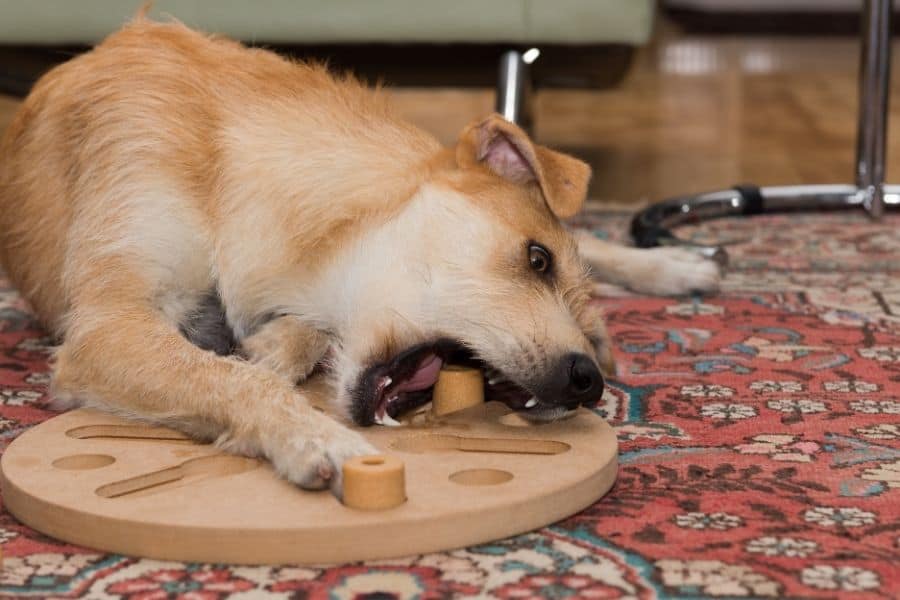
Engage the Brain
Dogs bred to hunt, herd, guard, and “critter” tend to have intense personalities and a love of learning, working, and challenging their brains.
Without appropriate outlets for all that big-braininess, nervous energy builds up, boredom sets in, and problem behavior ranging from simple misbehavior to neurosis can set in.
Every dog needs the opportunity to engage its brain. This mean providing some sort of mental application suited to your dog’s instincts, energy, and talents, with the ability to engage in drive-appropriate activities.
Ideas for keeping your dog’s brain occupied:
10 Brain Games to Play With Your Dog
Three Simple Nose Work Games to Play With Your Dog
Create Opportunities to Explore
Exploration is more than just exercise. It’s activity that satisfies the fundamental canine need to hunt, seek out, and discover.
You don’t necessarily need to head to the wilderness to satisfy your dog’s instinct to explore (although that’s always awesome).
Seeking out adventure can take many forms, all of which can discharge excess tension and help your dog stay emotionally even-keeled.
And – it’s a good way to keep you and your dog from getting in a rut!
Try taking your daily walk somewhere new. Visit that park across town you’ve been meaning to explore. New places means satisfyingly new sights and smells for your dog.
If you always train in the same place, (yard, driveway, kitchen, local park), go somewhere new. I like to do what I call “training fieldtrips”.
Training in new places tests your dog’s response in unfamiliar environments, and helps improve his focus. But it also enriches his senses and satisfies his mind.
Exploration and active enrichment for dogs:
Enrichment Adventures for Dogs: Reduce Stress and Improve Behavior
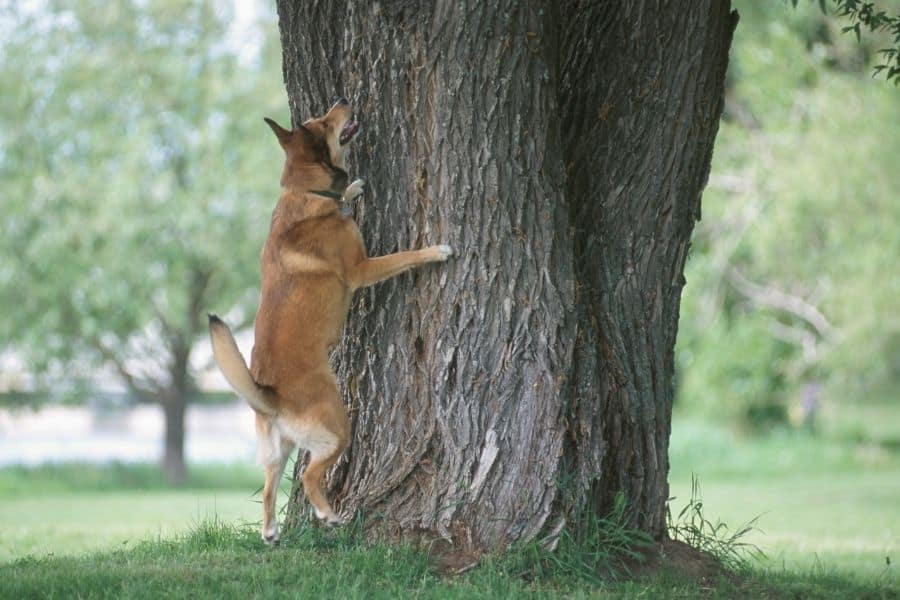
Reduce Triggers
There are a number of situations and interactions that can be a source of anxiety or frustration for dogs.
If you see that your dog sometimes displays an unusual level of anxiety or frustrated arousal, it’s time to learn what’s triggering the reaction.
Once you understand the triggers, you can work on modifying your dog’s environment, routine, and/or your interactions to reduce or eliminate those triggers.
Making some simple changes may reduce or even eliminate your dog’s anxious or frustrated reaction, so this is a biggie!
Understand what causes and triggers OCD events:
Common Triggers for OCD Behavior in Dogs
Avoid an “Always On” Mentality
Highly active, and intense, driven dogs can have trouble learning to truly settle and be internally “quiet”.
They’re great when actively working, playing, and applying themselves, but not so good when not “on the job”.
In some dogs this is related to their natural intensity. In others, it has more to do with their need to be working with their person (in which case the dog has trouble settling when you’re around, but can do so if alone or confined).
Both types of dogs need to learn how to relax, and be taught that they do not always need to be “on”. High-strung, intense dogs that don’t learn this skill are more prone to developing OCD behaviors.
Teaching your dog how to relax:
Karen Overall’s Relaxation Protocol
Balance before Specialization
A flexible, thinking mindset is very important for avoiding OCD in dogs. If you plan to compete with your dog in specialized training activities, such as high-level dog agility, avoid over-concentrating your dog’s training too early.
Aim for balance rather than specialization the first couple of years of your dog’s life. You can narrow down your dog’s focus once he’s more mature and practiced in mental dexterity.
Ideas for introducing balance to your dog’s training regimen:
Training for Multiple Dog Sports – Cross-Training Does Work!
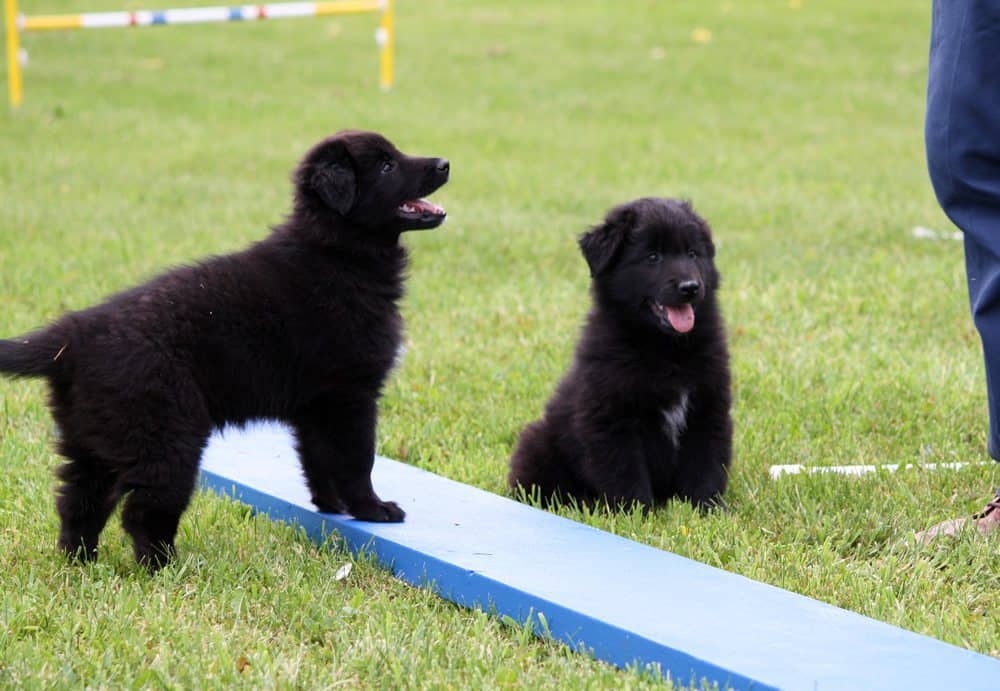
Prevention through selection
It’s worth mentioning that one of the best ways to prevent OCD behavior is through careful selection of your future puppy or adult dog.
A dog’s ability to handle stress is partly genetic, and partly a factor of its early environment, handling, and socialization. (“Early” meaning all those weeks before a puppy goes to its new home.)
When you select a pup with a strong, solid temperament and raised by a conscientious, proactive breeder, you’re selecting a puppy more likely to be resistant to developing compulsive behavior under stress.
On the other hand, weak temperament (including poor ability to deal with stress, and/or an anxious, fearful, or under-confident attitude), as well as less-than-ideal early upbringing can be factors in the development of OCD behavior in dogs.
How to Test and Select a Puppy for Temperament
If you’re considering an intense pup with lots of natural drive, think honestly about whether you’re prepared to channel all that energy and instinct with meaningful, satisfying work. Lack of work in high-drive dogs can result in pent up mental energy and frustration. Both are considered strong contributing factors for OCD in dogs.
Wrapping Up
For dogs susceptible to compulsive behavior disorder, whether through genetics or temperament, the surest course for stopping OCD behaviors may be to keep them from starting in the first place.
Since we know that social, lifestyle, and environment factors play a significant role in the development of OCD in dogs, it makes sense to do our best to eliminate or reduce those potential causes.
For dogs with a strong family history of OCD, the precautionary steps discussed here may at least minimize the severity, if OCD does develop.
I hope this article has given you some food for thought and ideas on how to support your dog’s emotional soundness and resiliency.
Remember, if your dog is showing signs of compulsive behavior, see your veterinarian first!
julie
(bio)
